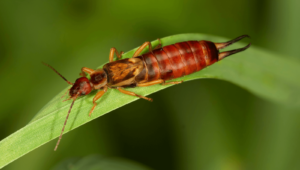Frequently Asked Questions About Earwigs in Wisconsin

Earwigs in Wisconsin play a major role in our delicate ecosystems by consuming pests like aphids and caterpillars. However, they can become unwelcome pests when they infest our homes.
Understanding what earwigs are and how they can enter houses is essential for infestation prevention. Let’s explore some key facts about earwigs.
What Are Earwigs?
Earwigs are small insects characterized by their elongated bodies, pincer-like appendages at the end of their abdomen, and membranous wings folded underneath short, leathery forewings.
Despite their name, earwigs do not typically crawl into human ears. They are primarily nocturnal and omnivorous, feeding on various organic matter, including plants, other insects, and decaying matter.
The most common species in Wisconsin is Forficula auricularia, known as the European earwig. This species is widespread across North America and is often found in gardens, agricultural areas, and urban environments.
What Do Earwigs Look Like?

Adult European earwigs have a dark brown or reddish-brown coloration and pincer-like appendages, called cerci, at the end of their abdomen. They use these appendages for defense and mating.
They typically measure between 12 and 16 millimeters in length, although they can sometimes reach lengths of up to 25 millimeters.
What is an Earwigs Lifespan?
In temperate climates like Wisconsin, these pets may live for about a year. During that time, they undergo their entire lifecycle from egg to adult.
- Egg Stage: Females lay clusters of eggs in soil or other suitable habitats.
- Nymph Stage: After incubation, the eggs hatch into nymphs. These nymphs resemble smaller versions of adults but lack wings and reproductive organs. Nymphs undergo several molts as they grow, shedding their exoskeleton to accommodate their increasing size.
- Adult Stage: Nymphs develop wings and reproductive structures once they reach maturity, becoming adult earwigs. Adult earwigs are capable of reproducing, continuing the life cycle.
What Do Earwigs Eat?
Earwigs are omnivorous insects, meaning they consume a variety of food sources. Their diet typically consists of:
- Plant Material: Earwigs feed on a wide range of plant material, including leaves, flowers, fruits, and tender shoots.
- Insects and Other Arthropods: These pests are opportunistic predators and scavengers, feeding on small insects, insect eggs, larvae, and other arthropods. They can help control populations of pests such as aphids, caterpillars, and mites.
- Decaying Organic Matter: In addition to live prey and plant material, earwigs feed on decaying organic matter, such as dead plants, fallen fruits, and compost.
- Occasional Protein Sources: In some cases, earwigs may scavenge protein-rich sources such as dead insects and small animals.
Are Earwigs Harmful to Humans?
Earwigs are generally not harmful to humans and do not significantly threaten human health or property.
Contrary to popular belief, earwigs do not crawl into human ears or lay eggs. This is a myth and has no scientific basis. These insects are not aggressive towards humans and typically only use their pincers for defense if they feel threatened. While their pincers may look intimidating, they are not strong enough to cause any harm to humans.
Although they are not harmful to humans, they can cause issues if they start to infest your home.
How Do Earwigs Enter a House?
Earwigs can enter homes through various openings and entry points. They are excellent at squeezing through cracks and crevices in walls, windows, doors, and foundations, exploiting even the smallest gaps.
Open doors, windows, or poorly sealed areas around window frames and door thresholds provide easy access. If not properly screened or sealed, vents, attic openings, and chimneys can also serve as entry points.
Gaps around utility lines, pipes, and wires entering the home also offer potential entry for earwigs. Given their attraction to moisture, these pests may be drawn indoors by leaky pipes, dripping faucets, or areas of high humidity.
Dense vegetation or overhanging tree branches near the home can serve as pathways for earwigs to access the house.
How to Prevent Earwig Infestations
To prevent earwig infestations, it’s essential to seal and secure potential entry points, maintain a clean and dry environment indoors, and address any moisture issues or outdoor attractants.
Regular landscaping maintenance, such as trimming vegetation and creating a barrier between the home’s exterior and landscaping, can help reduce the likelihood of these insects from finding their way indoors.
The professionals at K&C Pest Control will help you identify those entry points and potentially prevent earwig infestations in the future by stopping them at the source.
Integrated Pest Management With K&C Pest Control
Are you looking for a trusted pest control specialist in the Fox Cities area? Our experts can assist with current earwig infestations or preventative measures to keep your property pest-free.
If you live in Oshkosh, Appleton, Neenah, Menasha, or the surrounding areas, contact us for an inspection, evaluation, and ongoing protection to experience the peace of mind that comes with a protected home.
“The crew that showed up was one-time, professional, courteous, and got the job done quickly. With their reasonable prices, I’ll definitely be calling them again.” — Jim
